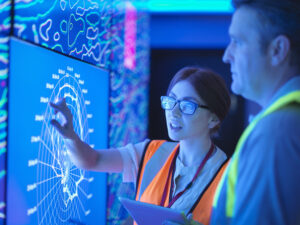
Changing patient expectations: Learning from Uber, Netflix, and Spotify

Throughout history, the progress of innovation has created an endless cycle of disruption. From horse-drawn carriages to trains, steamships, automobiles, and airplanes, the next big thing seems to always be around the corner, driven by those looking to give consumers an experience they didn’t even know they wanted.
As a result, technology has emerged as a significant source of recent disruption, thanks to innovators with an idea of doing things differently. Consumers are also changing the game, demanding friction-free, personalized experiences that fit their lifestyle.
In healthcare, today’s system still operates under an unsustainable, reactive care model. Now that consumers know what’s possible, disruption is inevitable. Since 90% of patients want to manage their own healthcare via technology, the industry needs a new system—one that proactively engages patients on their terms to avoid chronic disease and enable holistic health and wellness.
To explore what this model could look like in your organization, let’s turn to three companies outside healthcare and consider how we could take advantage of their innovation to craft a new approach.
Uber: Full transparency means no surprises
Before ridesharing came along, catching a cab meant calling a dispatcher or hoping one was nearby to hail. With fares charged incrementally by distance, it was difficult to tell what the total would be, and the rider experience was inconsistent depending on the driver, whose credit card machine never seemed to be working.
When Uber launched in 2009, everything changed. They disrupted the transportation industry almost overnight by flipping the focus to the passenger. By mapping out the end-to-end customer experience to identify customer pain points, they designed a transparent service that largely eliminated them. Their mobile-first model gives the customer constant access to information, from inputting their route and getting a cost estimate, to driver notifications, arrival times and automatic payment. They also developed a quality control system where riders could rate drivers and vice-versa.
Healthcare can learn a lot from Uber, since many existing systems weren’t built with patients (or clinicians) in mind. As patients interact with providers, they encounter similar friction that could be reduced by mapping pain points to redesign patient-first systems. For instance, Uber requires users to enter their profile information once and it flows across the app every time they use it. Imagine a healthcare system where a patient’s profile automatically flowed from their primary care doctor to each specialist and didn’t require them to re-write their health information at every stop along the way.
Consider Uber’s model of always knowing your driver’s location. What if patients had access to the same transparency, such as wait times for your provider, or easy-to-access mobile status updates for common tasks such as prescription refills or lab results? A patient-first system could even introduce quality ratings for patient experience, giving patients more control over their care as well as providing valuable feedback.
By reimagining care systems to put patients at the center of their experience, providers can achieve greater transparency and reduce key points of friction, laying the groundwork for improvements in patient engagement.
Netflix: Delivering curated content on demand
Before streaming video came along, watching television or movies required viewers to tune in each week, sift through channels for their next favorite show, scramble to make a movie before tickets sold out, or stop by a rental store and hope a copy was still available.
Over the past two decades, Netflix upended content delivery by recognizing the infrastructure for delivering entertainment wasn’t sufficient. To meet the new needs of consumers, they decided to put customers in charge of their own viewing experience.
They started small—first disrupting the Blockbusters of the world by delivering a better experience, which opened the door to even greater disruption when they moved into streaming. By delivering high-quality streaming content that could be consumed at any time, on any device, they essentially invented the idea of binge-watching. They also offered their own programming, providing new avenues for content outside of traditional television.
Healthcare can take a page from the Netflix playbook to change the current delivery model for modern needs by considering where and when patients access care and exploring how it can be tailored to individual patient preferences. The reactive care model is already giving way to preventative and chronic disease care, which requires a new infrastructure to deliver tailored experiences at scale.
For example, similar to Netflix’s “anywhere, anytime, on any device” approach, healthcare should continue implementing telehealth and telemedicine tools to deliver virtual care around the clock, not just in-person office hours. Their original content approach also offers an intriguing opportunity for providers. What if organizations could develop mobile health apps that streamed clinician-approved content on a host of topics to better engage patients in their health and deliver proactive care? They could also recommend relevant articles based on the patient’s location, specific condition or life milestones.
By creating a new, scalable infrastructure based on evolving patient needs, providers can give patients more control over their care, enable stronger engagement, and empower them to take a more active role through personalized care plans.
Spotify: Personalizing the listener experience
Similar to video, streaming music services first shook up the industry by disrupting the delivery model—putting consumers in charge of their music on any device, and at different price points. Before streaming, music fans were at the whim of record labels and the radio.
Streaming music was just the beginning, and Spotify took it to the next level. Building off the streaming model, Spotify furthered disruption by not only providing the product, but using customers’ behavioral data to personalize the experience, benefitting both the listener and the artists. They integrated data from multiple sources to make recommendations and tailor the listener experience over time, ensuring a continuous feedback loop of relevant, actionable data.
Spotify’s methods are highly relevant to healthcare. By unifying patient data from both clinical and non-clinical sources to get a more comprehensive view of their patients, providers can apply those insights to build a modern, tailored patient experience.
For example, like Spotify’s data-driven approach, providers could examine a patient’s clinical data along with behavioral, social and environmental data using artificial intelligence (AI) to predict future health risks, enabling them to avoid or mitigate chronic disease. Using the patient’s genomic profile, they could use genomics to analyze similar profiles, determine optimal treatment options and create a more personalized plan. They can also continue to foster innovation in remote monitoring by feeding patient-generated data from wearables and other IoT-enabled devices into the broader patient picture to better inform decisions and actions.
Leveraging patient data from both inside and outside the clinical setting enables health organizations to personalize the patient experience and glean valuable insights that can be used to improve outcomes.
Empower your innovation journey
While Uber, Netflix and Spotify span multiple industries, the ripples from their disruption extend far beyond, providing valuable examples the healthcare industry can use as a blueprint to create a new infrastructure around personalized, preventative care. No matter where you are on your innovation journey, you can empower your organization to take steps toward change, paving the way for even greater disruption and better care.
Learn more about Microsoft’s intelligent cloud offerings by downloading our eBook on digital transformation in health.




